
The brown hairstreak is a butterfly in the family Lycaenidae. The range includes most of the Palaearctic.

The purple hairstreak is a butterfly in the family Lycaenidae distributed throughout much of Europe, North Africa, Anatolia, Caucasia, and Transcaucasia. The larva feeds on Quercus robur, Quercus petraea, Quercus cerris and Quercus ilex.

The grayling or rock grayling is a species in the brush-footed butterfly family Nymphalidae. Although found all over Europe, the grayling mostly inhabits coastal areas, with inland populations declining significantly in recent years. The grayling lives in dry and warm habitats with easy access to the sun, which helps them with body temperature regulation.
Hipparchia azorina, the Azores grayling, is a species of butterfly in the family Nymphalidae. It is endemic to the Azores. Its natural habitats are temperate forests and temperate grassland. It is threatened by habitat loss.

The yellow-spotted ringlet is a member of the subfamily Satyrinae of the family Nymphalidae. It is associated with (sub)alpine meadows at 900–2,500 m above sea level. It is found in the Alps, the Pyrenees, the Cantabrian Mountains, the Massif Central, the Vosges Mountains, the Carpathian Mountains and the mountains of Herzegovina.
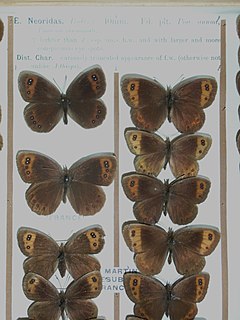
The autumn ringlet is a member of the Satyridae subfamily of the family Nymphalidae. It is a high-mountain butterfly found in the Pyrenees, Alps and in Italy.
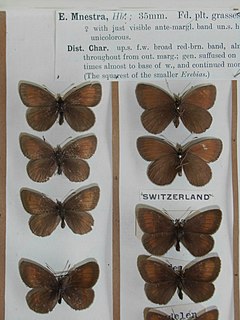
Mnestra's ringlet is a member of the subfamily Satyrinae of the family Nymphalidae. It is a mountain butterfly found in the Alps of Austria, France, Italy and Switzerland. The Mnestra's ringlet is named for Mnestra, a daughter of Erysichthon, king of Thessaly in Greek mythology.

Hipparchia hermione, the rock grayling, is a butterfly of the family Nymphalidae. The species can be found in Central Europe, Southern Europe, Eastern Europe, North Africa, Anatolia and the Caucasus.

Spilosoma lubricipeda, the white ermine, is a moth of the family Erebidae. It is found throughout the temperate belt of Eurasia from Europe through Kazakhstan and southern Siberia to Amur Region, China, Korea and Japan. In China several sibling species occur.
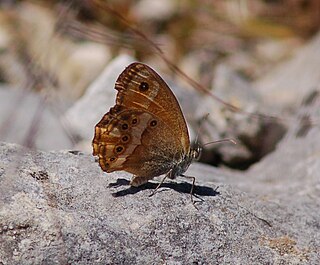
Coenonympha dorus, the dusky heath, is a butterfly of the family Nymphalidae. It is found in south-western Europe and North Africa.
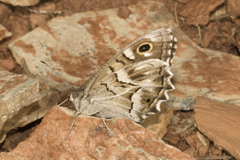
Hipparchia fidia, the striped grayling, is a butterfly of the family Nymphalidae. It is found on the Iberian Peninsula, the Balearic Islands and in south-eastern France and the bordering parts of Italy and North Africa.

Erebia pandrose, the dewy ringlet, is a member of the subfamily Satyrinae of the family Nymphalidae. It is found from the Arctic areas of northern Europe, the Pyrenees, Alps, the Apennine Mountains, the Carpathian Mountains, Kola Peninsula and Kanin Peninsula, part of the Ural and the Altai and Sayan Mountains up to Mongolia.

Coenonympha corinna, the Corsican heath, is a butterfly in the family Nymphalidae

Fabriciana elisa, the Corsican fritillary, is a butterfly of the family Nymphalidae. It is found in Corsica and Sardinia. This is a mountain butterfly, found on grassy vegetation in clearings in deciduous woods.

Acraea jodutta, the jodutta acraea, is a butterfly in the family Nymphalidae. It is found in Guinea, Sierra Leone, Liberia, Ivory Coast, Ghana, Togo, Nigeria, Cameroon, Equatorial Guinea, São Tomé and Príncipe, Gabon, the Republic of the Congo, the Central African Republic, Angola, the Democratic Republic of the Congo, Sudan, Uganda, Kenya and Ethiopia.
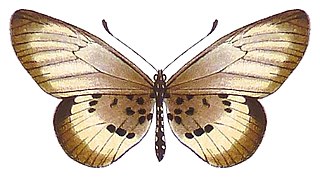
Acraea peneleos, the Peneleos acraea, is a butterfly in the family Nymphalidae, which is native to the tropics and northern subtropics of sub-Saharan Africa.
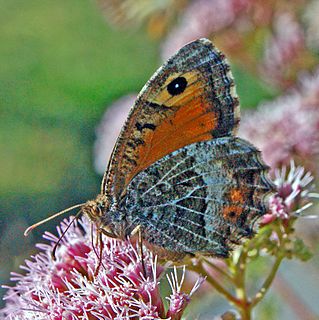
Arethusana is a butterfly genus from the subfamily Satyrinae of the brush-footed butterfly family (Nymphalidae). It is composed of only one species, Arethusana arethusa, the false grayling.
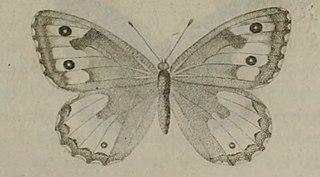
Hipparchia aristaeus, the southern grayling, is a butterfly of the family Nymphalidae. It was described by Franco Andrea Bonelli in 1826. It is found in North Africa, southern Europe and Asia Minor. The habitat consists of hot dry rocky areas.

Boeberia is a genus of satyrine butterflies containing a single species Boeberia parmenio found in the Altai mountains South Siberia, Mongolia, Yakutia, Amur and North east China.
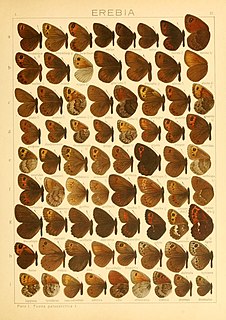
Erebia dabanensis is a small butterfly found in the East Palearctic that belongs to the browns family.



















